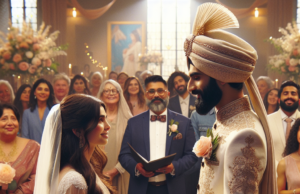
Frequently Asked Questions about Common Law Marriage in South Dakota
What is a common-law marriage in South Dakota?
A common law marriage in South Dakota would be considered a marriage in which no marriage licenses were received, nor were there any formal recognition of legal union.
Instead, a common-law marriage in South Dakota becomes recognizable once both parties agree that they are, in fact, married and carry on with a relationship similar to those shared by traditionally married couples, particularly a relationship marked by cohabitation and monogamy.
The reason that someone would like to get a common law marriage in South Dakota is that it entitles a person to all the same rights of marriage. For instance, a spouse of someone via common law marriage in South Dakota will be entitled to their insurance program’s spousal health benefits.
Additionally, they will qualify as a spouse on federal tax forms. Finally, any benefits payable upon death, such as life insurance benefits, will automatically go to a spouse, even a spouse via common law marriage, unless other issues are raised.
The purposes of common law marriage in South Dakota are centuries old. It dates back to the time before cars, when individuals living in isolated settings, particularly in a relatively rural state like South Dakota, might not have ready access to a priest.
The flexibility of common law marriage also allowed thousands of women to save their reputation when out-of-wedlock intercourse was more of a taboo than it is now.
Can I get a common law marriage in South Dakota?
No. Unfortunately, common law marriage in South Dakota was banned in 1959.
As the reasons for common law marriage in South Dakota slowly began to evaporate—cars made priests and city officials more accessible while growing tolerance led to the decreasing stigma surrounding children born outside of marriage—the state’s animosity toward it grew.
Records were depended on more and more to make sure that benefits were doled out appropriately, and the lack of records which common-law marriages demand made it anathema for the state.
Are there any alternatives to common law marriage in South Dakota?
Yes, if you wish to get a common law marriage in South Dakota, there may still be one or two options for you to successfully explore.
You should know that there is a built-in grandfather’s clause with the current ban on common law marriage in South Dakota, which means that any marriage which began in 1959 or prior is still valid.
Of course, determining when a common-law marriage began is very difficult, but if you can prove that cohabitation began in 1959, you might be on your way to demonstrating this to a court.
The other fact that you should be aware of is that some other states do recognize common law marriage, and you can get a common-law marriage there.
What’s more, South Dakota will be legally obligated to respect your common law marriage and treat it like a typical one with all the benefits that implies. If you need legal advice and assistance, contact South Dakota lawyers.
Introduction
When we think of marriage in the United States, we often think of the traditional wedding ceremony where two individuals exchange vows in front of their loved ones and a licensed officiant. However, not all states in the U.S. require a formal marriage ceremony to recognize a legal union between two individuals. South Dakota is one of the few states that still recognizes common law marriage as a valid form of marital relationship.
In this article, we will delve into the specifics of common law marriage in South Dakota. We will discuss what common law marriage is, how it is recognized in South Dakota, and the rights and obligations that come with it.
What is Common Law Marriage?
Common law marriage is a type of informal marriage that exists in some states in the U.S. It is a legal union between two individuals who have lived together for a significant amount of time without a formal ceremony or marriage license from the state. Common law marriages are often mistakenly referred to as “”common law”” unions or partnerships, but that is not accurate as those terms do not have legal meaning and are not recognized as marriages in any state.
The legal requirements for common law marriage vary from state to state. In general, they include:
1. Co-habitation requirement – The couple must live together for a certain period of time, usually several years or longer, with the intent to establish a marital relationship.
2. Mutual consent – Both parties must agree to be in a marital relationship, and must present themselves to the public as a married couple.
3. Holding out – The couple must present themselves to the public as a married couple, meaning they introduce each other as husband or wife and may file joint taxes or apply for joint credit.
In South Dakota, a common law marriage is recognized if it meets the following requirements:
1. Both parties are at least 18 years of age or older.
2. Both parties consider themselves to be married.
3. Both parties openly cohabitate.
4. Both parties present themselves to others as being married.
5. The duration of the relationship is important; the couple must have lived together for a period of time long enough to establish a marital relationship. There is no specific time requirement set in law regarding how long a couple must have lived together.
However, if one or both parties are under 18 years of age, the common law marriage is invalid. This is because the legal age to enter into a contract, including marriage, in South Dakota is 18 years old.
How is Common Law Marriage Recognized in South Dakota?
When it comes to common law marriage, South Dakota is a state that still recognizes it as a valid marital relationship. In order to establish a common law marriage in South Dakota, both parties must meet certain requirements and act as though they are married. The key to recognizing a common law marriage in South Dakota is that both parties consider themselves married and behave in a way that reflects that belief.
In South Dakota, common law marriage is often established through evidence that demonstrates the couple’s intent to be married, such as joint financial accounts, signing each other’s last name, filing taxes jointly, and referring to each other as “husband” or “”wife””. In the event of a divorce or separation, the same considerations are taken as with any other legally married couple, including division of assets and debts accrued during the duration of the relationship.
The State of South Dakota does not require a couple to obtain a marriage license or have a formal ceremony to be considered married under common law.
Rights and Obligations of Common Law Marriage
Common law marriage in South Dakota provides certain rights and obligations for couples who meet the requirements to establish a legal union. These include:
1. Spousal support – In the event of a separation or divorce, one spouse may be required to provide financial support to the other if they can demonstrate that they are entitled to it under the law. This can include temporary spousal support, long-term spousal support, or rehabilitative support.
2. Property rights – If a common law couple separates or divorces, the marital property may be divided in a similar way as it would be during a traditional divorce. In South Dakota, marital property is generally divided equally unless the court determines that an unequal division is necessary.
3. Child custody and support – If the couple has children together, they will be subject to the same laws regarding child custody and support as a legally married couple. This may include disputes over legal custody, physical custody, visitation rights, and child support.
4. Health care benefits – Employees of the state of South Dakota who are in a common law marriage are eligible for health care benefits for their spouse. South Dakota state employees are not required to obtain a marriage certificate in order to receive health care benefits.
5. Inheritance rights – If one spouse dies, the surviving spouse may be entitled to inheritance rights if the deceased spouse had no will or the will left property to the surviving spouse.
Conclusion
Common law marriage is a legal marital relationship recognized in the state of South Dakota. It is established by the mutual consent and cohabitation of two individuals who intend to present themselves to the public as being married. Unlike traditional marriage, a couple who establishes a common law marriage in South Dakota does not need a marriage license or formal ceremony.
Although some states have abolished common law marriage, South Dakota still recognizes it, and couples who establish a common law marriage are entitled to the same legal rights and obligations as those in a traditional marriage. It is important to note that establishing a common law marriage requires meeting certain standards, such as cohabitation and mutual consent, and the court may determine if a couple has met these requirements if there is a dispute over whether a common law marriage existed.
Overall, while common law marriage is not as common as it once was in the United States, it remains a viable way for couples to establish a legally recognized marital relationship in South Dakota.



















